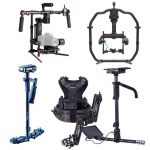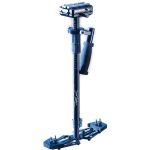Steadicams, Glidecams and 3-axis Digital Camera Gimbals

Many people ask me what is better, a digital 3-axis gimbal or a traditional steadicam? I would say they both have their advantages and disadvantages, and depending on the situation, one might be better than the other.
Gimbals area easy to use, meaning you can start getting smooth shots fast. But they are also a lot more expensive and less reliable – they require more trouble shooting with batteries, settings, etc. Similarly, they are susceptible to weather elements. Finally, gimbals can produce movement that is a bit stiff and robotic.
On the other hand, old-fashion stabilizers produce organic movement, and they are durable and reliable – they almost always work. However, you need to take the time to learn how to use them.
I have a very extensive set of reviews and tutorials about glidecams and steadicams. So, check them out if you want to learn how to balance and use traditional stabilizers.
Having used many different stabilizers, here are a few I can personally recommend.

The best all-around traditional stabilizer is the Devin Graham series Glidecam, which I reviewed here. I like it because it works with big and small cameras, and it is very fast to set up.
When it comes to full steadicams, the one I use is from CAME-TV. It can be used as a glidecam, or combined with an arm and vest for a full steadicam kit. Here is my review of it.
If you want a 3-axis digital gimbal, then I recommend CAME-TV, too. Their gimbals offer very good performance at a competitive price.

My favorite one is the ARGO – you can see the review here.
For heavier cameras I would go with the CAME-TV Prodigy (here is my review).
Another great gimbal for heavier cameras is the recently released DJI Ronin 2. I had a chance to use it a trade show, and the gimbal looks amazing, but… it’s also very expensive. Therefore, I think the two CAME-TV gimbals mentioned above are a better buy. Still, if you want the absolute best and can afford it, then that’s the gimbal to look at.
DJI Ronin 2 3-axis stabilizer on B&H, Adorama
Camera Gimbal Support Systems
Some camera and gimbal set-ups are heavy, which makes them difficult to use for extended periods of time. That’s when you want to use something like a steadycam jacket, but designed for camera gimbals.
Generally, there are two types of such support systems: either with a single arm above the camera operator’s head, or with two arms going above the shoulders.
The single arm is easier and faster to set up, but the disadvantage is that the arm sticks out high above the head of the operator. This makes it hard to get through doorways. etc.
The dual arms, on the other hand, don’t go higher than the operator’s head. The downside is that they usually require another person to help attach the arms to the camera rig.

Gimbal support systems are usually very expensive. I have tested the two below, and they are great – aside from the price.
Easyrig Vario 5 on B&H, Adorama
Ready Rig GS Stabilizer on B&H, Adorama
Here are two other options – much cheaper ones – that I’ve done reviews for:
Flycam Flowline 750N camera support review
Atlas camera support review
